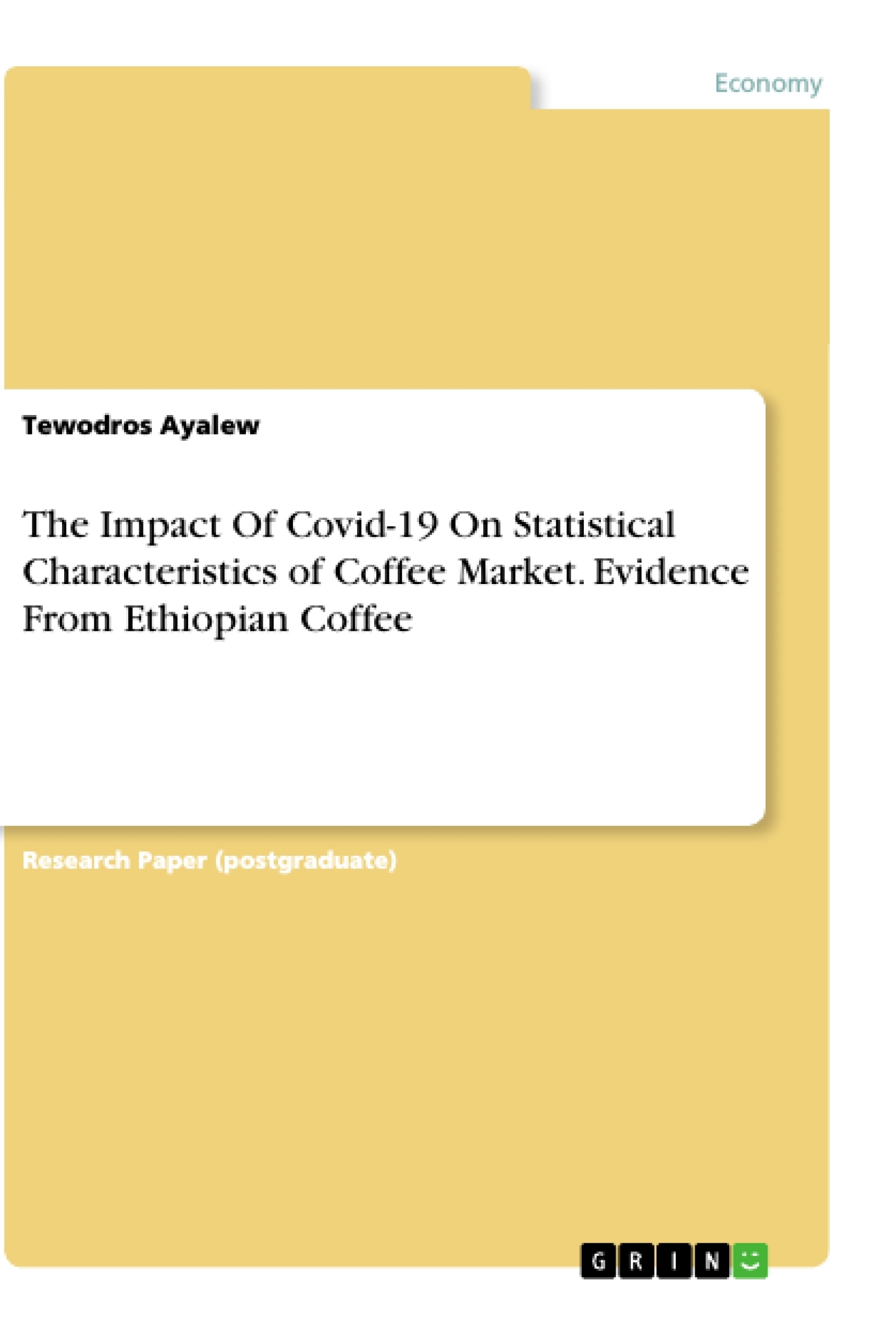Following the recent world crisis as a result of COVID-19 pandemic, the world has suffered tremendous losses in almost all market sectors that form the global economy. In this light, the researchers have decided to carry out a market research in one of the sectors of the global economy which is the commodity market. That market has a booming characteristic specifically the Ethiopian coffee export market. Therefore, it will be the project point of focus.
The capstone project focuses on analysing 30 years of data and the current year before and after the COVID-19 pandemic, as well as during the period it has existed. The research used a couple of modern day tools to gather and analyse the data which has been collected from the Ethiopian Coffee Authorities. Tools such as Python and Excel have been used to develop a model for prediction and to test the hypothesis such as the ARIMA, Simple Linear Regression as well as the Paired T-test. Correlation and Covariance analyses have been carried out to test the relationship between the Ethiopian coffee market and the global economy participants such as the US and China to evaluate the degree of relationship and to find out whether the COVID-19 Pandemic has any effects on the coffee market in Ethiopia. The research result shows that the Ethiopian coffee export market will double its revenue for the coming 10 years.
The project find out COVID-19 has a significant negative relationship with the coffee market but as compared with other countries disasters, the coffee export market in Ethiopia has been slightly impacted, there was still significant growth in the market during this period due to governmental policies put in place to protect the market from crashing or suffering from very heavy losses over time. It can be considered as a role model for other world countries in combating the pandemic to protect the market.
Inhaltsverzeichnis (Table of Contents)
- ACKNOWLEDGEMENT
- ABSTRACT
- CHAPTER ONE
- Introduction
- Project Track
- Problem statement
- The Goals and objectives of the study:
- Specific objectives:
- CHAPTER TWO
- Literature Review
- Current Situation Regarding COVID-19 Pandemic
- Current Coffee Market concerning COVID-19 and forecast
- Coffee Export Market in Ethiopia
- Export and local consumption
- Pricing
- The expected investor's behaviour and new market characteristics caused by COVID-19
- Price Volatility of the coffee market
- The relevance of this research as compared with other research (Empirical Evidences)
- Competitors Analysis in Ethiopian coffee market
- Strenghts
- Weaknesses
- Opportunities
- Threats
- CHAPTER THREE
- Method
- CHAPTER FOUR
- Data Analysis and Interpretation
- Introduction
- Data interpretation and analysis
- Application of econometrics tools
- Data interpretation and analysis
- Summary of results analysis and recommendation
- Linear Regression
- Data visualization and regression analysis
- Analysis and Interpretation
- Paired T-Test
- Hypothesis Testing
- Analysis and Interpretation of the result
- Correlation and covariance analysis of the Ethiopian coffee export
- Correlation
- Data analysis and interpretation Seaborn Correlation Heatmap:
- Seaborn Pairplot
- Matplotlib Correlation Heatmap
- Data Analysis and Interpretation
- CHAPTER FIVE
- Conclusion
- Recommendations
- Bibliography
Zielsetzung und Themenschwerpunkte (Objectives and Key Themes)
This capstone project aims to analyze the impact of the COVID-19 pandemic on the Ethiopian coffee export market. Utilizing 30 years of data, the research focuses on understanding the market's dynamics before, during, and after the pandemic. By employing statistical tools like ARIMA, Simple Linear Regression, and Paired T-test, the study aims to identify key trends and predict future revenue growth.
- The impact of COVID-19 on the Ethiopian coffee export market.
- The relationship between the Ethiopian coffee market and global economic participants like the US and China.
- The effectiveness of government policies in mitigating the impact of the pandemic on the coffee market.
- Predicting future revenue growth in the Ethiopian coffee export market.
- Identifying key trends and patterns in the coffee market over the past three decades.
Zusammenfassung der Kapitel (Chapter Summaries)
Chapter One introduces the research project, outlining its objectives and problem statement. It highlights the study's focus on understanding the impact of COVID-19 on the Ethiopian coffee export market. Chapter Two provides a comprehensive literature review, exploring the current situation regarding the COVID-19 pandemic, its impact on the global coffee market, and specific insights into the Ethiopian coffee export market. This chapter examines factors like export and local consumption, pricing, investor behavior, and price volatility.
Chapter Three outlines the methodological approach employed in the research. Chapter Four delves into the data analysis and interpretation, presenting a thorough examination of the collected data using statistical tools. The chapter analyzes trends in the Ethiopian coffee market before, during, and after the pandemic, focusing on linear regression, paired t-tests, and correlation and covariance analyses. The chapter also discusses the application of econometrics tools and the interpretation of the results.
Schlüsselwörter (Keywords)
This research explores the impact of the COVID-19 pandemic on the Ethiopian coffee export market, utilizing a combination of statistical techniques and data analysis. Key terms and concepts include: Ethiopian coffee export market, COVID-19, market dynamics, revenue growth, prediction, statistical modeling, ARIMA, Simple Linear Regression, Paired T-test, correlation analysis, covariance analysis, global economic participants, government policies, and market trends.
- Quote paper
- Tewodros Ayalew (Author), 2020, The Impact Of Covid-19 On Statistical Characteristics of Coffee Market. Evidence From Ethiopian Coffee, Munich, GRIN Verlag, https://www.grin.com/document/957080




